2004 VOLKSWAGEN GOLF PLUS engine
[x] Cancel search: enginePage 29 of 541
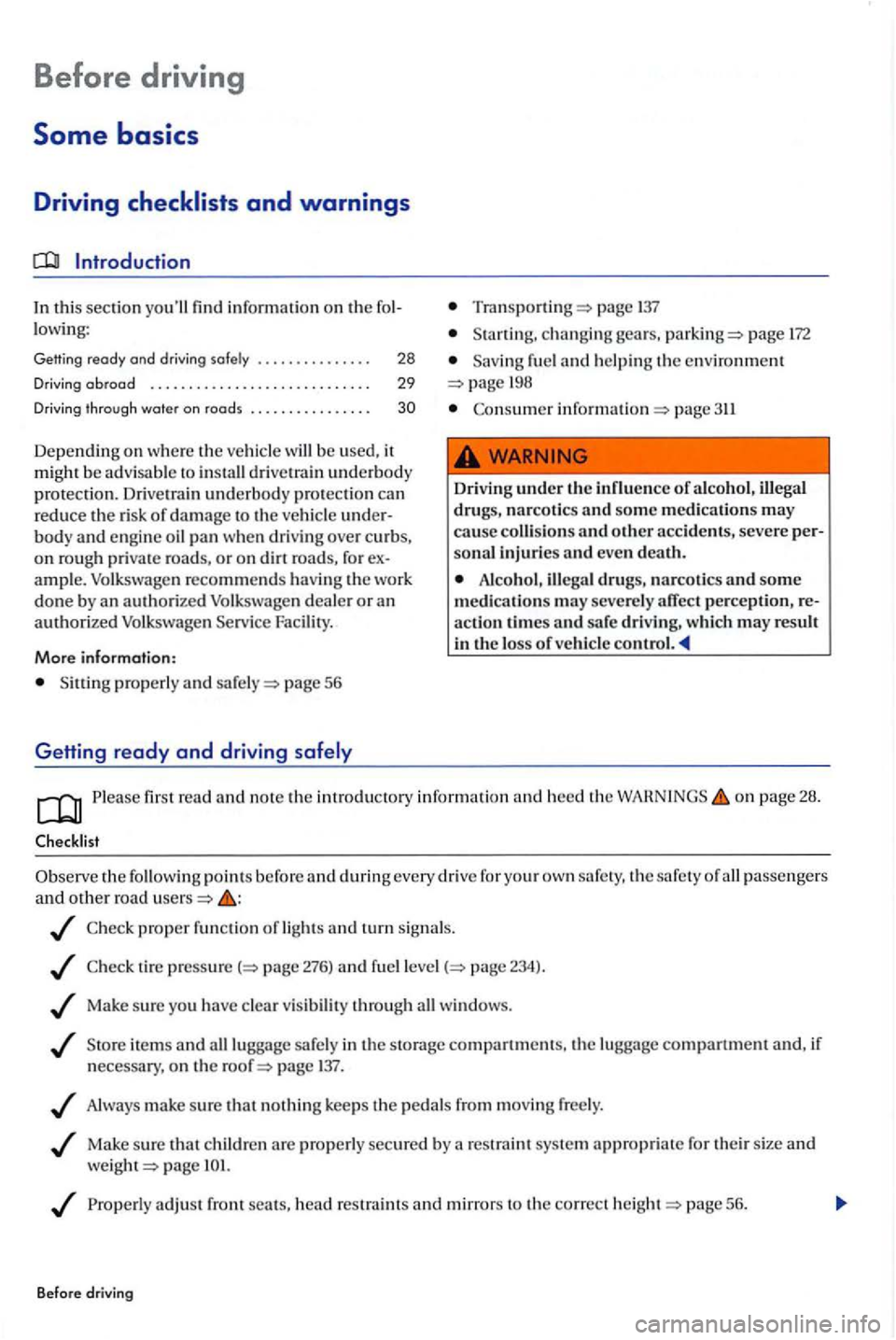
Before driving
Some basics
Driving
In this sectio n find information on th e lowing:
Getting ready and driv ing safely . . . . . . . . . . . . . . . 28
Driving abroad . . . . . . . . . . . . . . . . . . . . . . . . . . . . 29
Driving through water on roods . . . . . . . . . . . . . . . .
Dep ending on where th e ve hicle be used, it
m igh t b e advi sable to dri vetrain underbod y protection. Drivetrain underbody p ro tection can reduce th e risk of d a m age to th e ve hicle body engine oil pan whe n drivin g ove r c urb s, on rough private roads, or on din roads, for am ple. V olkswagen recomme nd s hav in g the work
d one by an auth orize d Volkswag en d ea le r o r an authorize d Volk swage n Facility.
More information:
proper ly and p age 56
Getting ready and driving
page 137
changin g gea rs. page 172
fuel h elpin g th e environm ent 198
Co nsumer page 311
Driv ing under the influen ce of a lco hol, iUegal drugs, narcotics and some medications cause colli sio ns o th er accident s, severe sonal injuries e ven dea th.
Alco ho l, ill ega l drugs, narcotic s and some medicatio ns may severe ly action times and s a fe drivin g, which may result
i n the loss of ve hicle
Please fir st read a nd not e th e introdu ctory information and heed the on page 28 .
the points befo re and during every drive for your own safe ty , th e safety of passenge rs and o th er road
pro per fun ctio n of light s and turn signals .
t ir e page 276) and fu el p age 234) .
Ma ke su re yo u have clear visi bility throu gh win dows .
item s and lugg age sa fely in the s torag e compartment s, the lu gg age compartment and, if
n ecess ary, on th e page 137 .
Always make sure that nothin g kee ps th e pedal s from mov ing free ly .
Mak e sure that ch ild re n are properly secured by a restraint sys te m appropriate for thei r size and
weig ht
Properly adjust front sea ts , h ead restraint s and mirrors to the correc t page 56.
Before driving
Page 31 of 541
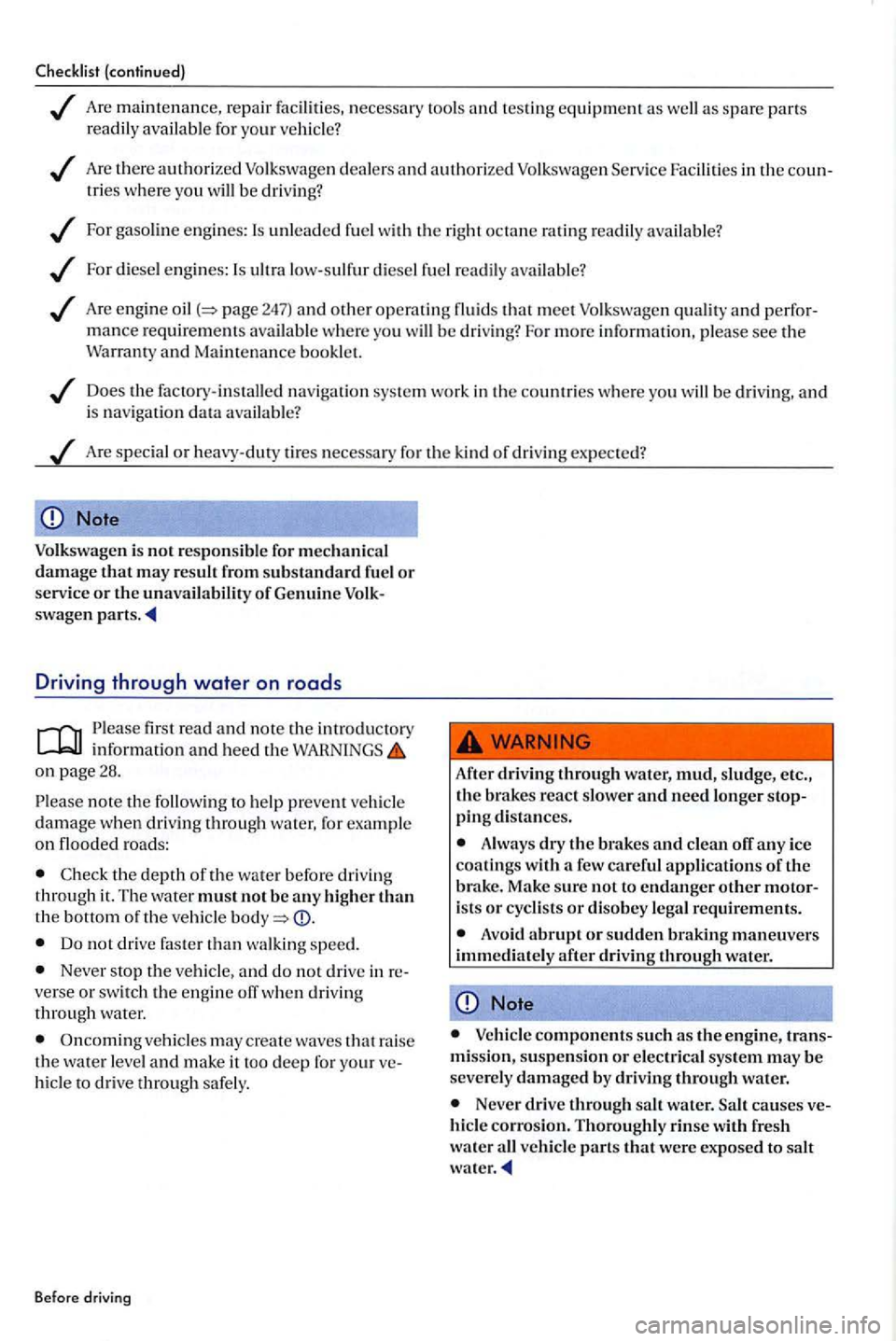
Are maintenance , repair facilitie s, necessary tools and t es tin g equipmen t as for your
Are th ere authorized Volkswagen dea le rs a nd authorized Volkswage n Fac ilities in the coun-trie s where you be driving?
For unleaded with the right octane ratin g readil y
For di es el eng ines: low-s ulfur diesel
Are engin e that meet Volkswagen and p erfo rmance requirements be dri ving"? F o r more inf ormatio n, please see the War ranty and Mai ntenance bookl et.
Does the factory- install ed nav igation system wor k in the co untries w here yo u be dri ving , and is nav igat io n data
Are sp ec ial or heavy-duty tires necessary for the kind of driv in g expec te d?
Note
Volk swagen is not responsible for mechanical damage that may re sult from substandard or service or the unavailability of Genuine Volk
swagen parts.
first read and note introd uctory informatio n and heed th e on page28.
note the following to preve nt damage when driving through wa ter, fo r examp le
o n roads :
Check depth of th e w ater before driving throu gh it. Th e wa te r must not b e any hi gher than th e bottom or the
Do no t dri ve faster than walkin g sp eed .
Never stop the a nd do n ot driv e in re
verse or swit ch the engine off when driving
through water.
Oncoming may create waves that raise the water to drive through safe ly .
Befo re driving
After driving through water, mud, sludge, etc., the brakes react slower and need longer stopping di stances.
A lw ays dry the brakes and
Avoid abrupt or sudden braking maneuvers after water.
co mponents such as the engine, transmission , suspension or electrical system may be sev erely damaged by driving through water.
Never drive through salt water.
parts that were exposed to salt water.
Page 32 of 541

Technical data
In thi s section yo u 'll find inf ormatio n on the fol
l owing:
.... _.. . . 31
Engi ne data and dimensions ......... _. . . . . . . . . 32
D im ensions . . . . . . . . . . . . . . . . . . . . . . . . . . . . . . . . . 33
Th e engine configu rat io n ca n be found on the ve
hi cle identification label in the Warranty an d
Maint enance bookle t or in th e officia l vehicle documents.
Specifications in ve hicl e documents al
way s take precede nce. Th e specificatio n s i n thi s
Manual r e fer to the basic m odel. The stated values m ay vary, dep ending upon diff erent equipment opti o ns o r models , a s well as with respect to special vehicles and vehicles exported to different countries.
45-7-5545
o
PRSSRT Lim. NRR
147kl.J
..
D9l 162 5RQ 5SL TQ3 352 BGV 12H
Fig. Vehicle identification Iobel: shown in the ex
ample with eng ine classi fication code BLF
read and no te th e introductory informatio n an d heed th e on page31.
V ehicl e id entification number
The ve hicl e identification number is on a plate on top of the in strument pan el o n the dri ver's s ide,
and is v isibl e from the outsid e th rough the windfig . The v iew window is on t h e side at the botto m of th e w ind shi eld. Th e vehicle identification number i s al so in the right drip
Some basic s
M ore informatio n:
page
Sav ing fuel and helping th e enviro nment
Fu el page 23 9
Engine page 247
En gin e page 252
Tires and 276
page 311
Disregarding or exceeding stated values for weights , loads, dimensions and maximum speed may result in accidents and serious per-son al
Fig. 11 Vehicle identification number
c h a
nnel. The drip ch annel is between the spring stru t towe r and the right fender.
p age 242.
Vehicle identification Iobel
T he ve hicle i
dentifi cation fig . is in th e area o f th e spare w heel well in the luggage
compartm en t a nd contains th e follo wing informa-
tion :
31
Page 33 of 541
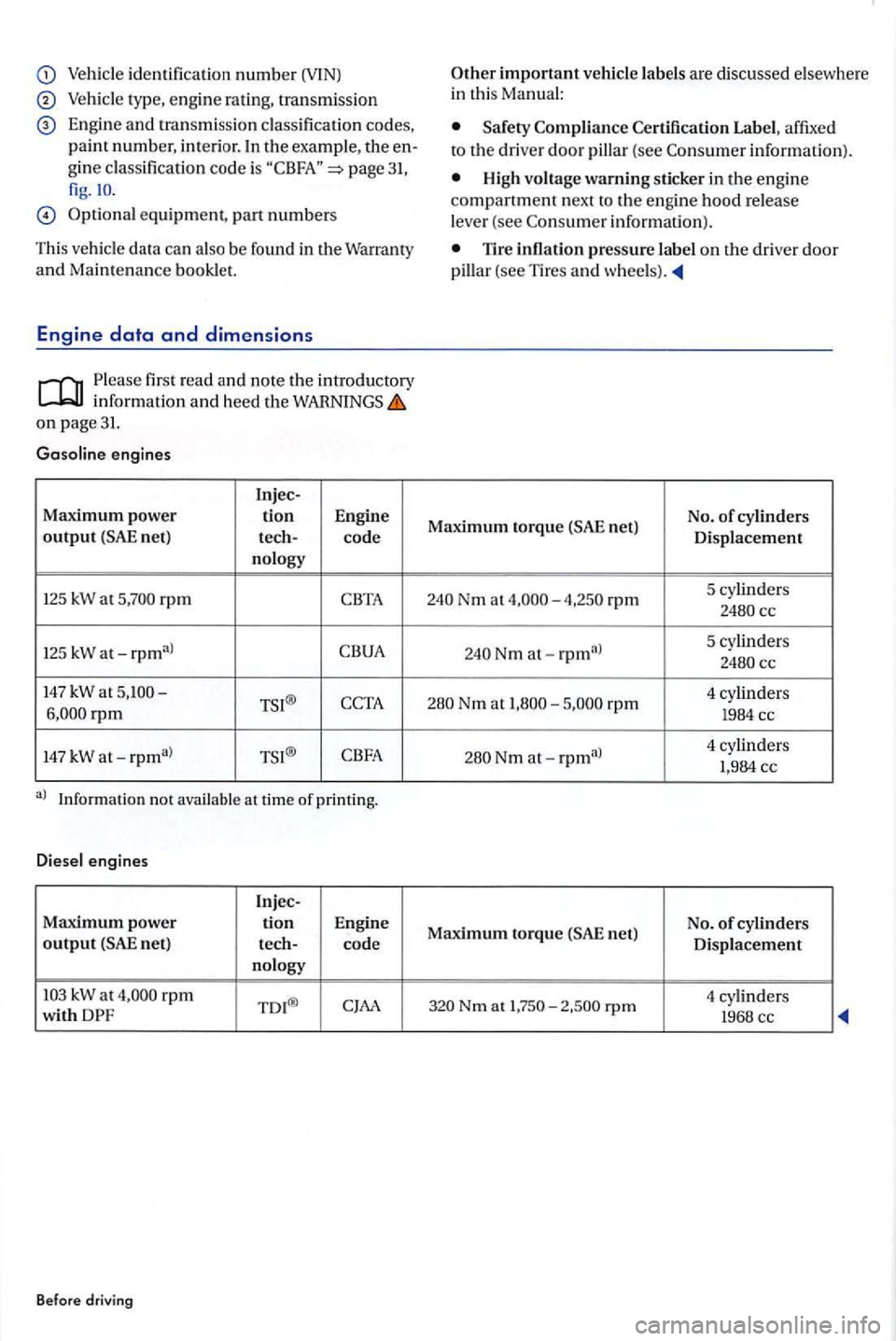
identificatio n number (VlN)
Veh icle type, eng in e rating , tran smission
E n gine and tra nsm iss io n classificatio n cod es, pain t num ber, interior. In the exa mple,
3 1, fig.IO.
equipment, part num bers
Thi s ve
hicle data can also b e fou nd i n t he War ra nty
and Maintenan ce booklet.
Engine data and dimensions
first read and note the in trod uctory inform ation and heed th e WARNINGS on page31.
G aso line engi nes
Injec -
Maxim um power
rp m
125 kW at-
147 kW at
kW at rpm T D I®
Before dri ving
Safety
i nfo rmatio n).
Hi gh vo ltage warning sticker in the en gin e compartment next to the eng ine hood r elease leve r (see in format ion) .
Tire infl ati o n pressure la b el o n th e driver door
pillar (see Tires and
Maximum torqu e net) N
o. of cy linders
Disp laceme n t
Nm at rpm 5 cy linders
5 cy linders
N m at-4 cylinders
1 ,984 cc
Max
imum torque n et) N
o. of cy lin ders
Di sp lacement
N m at rp m 4 cylinde
rs 196 8 cc
Page 34 of 541
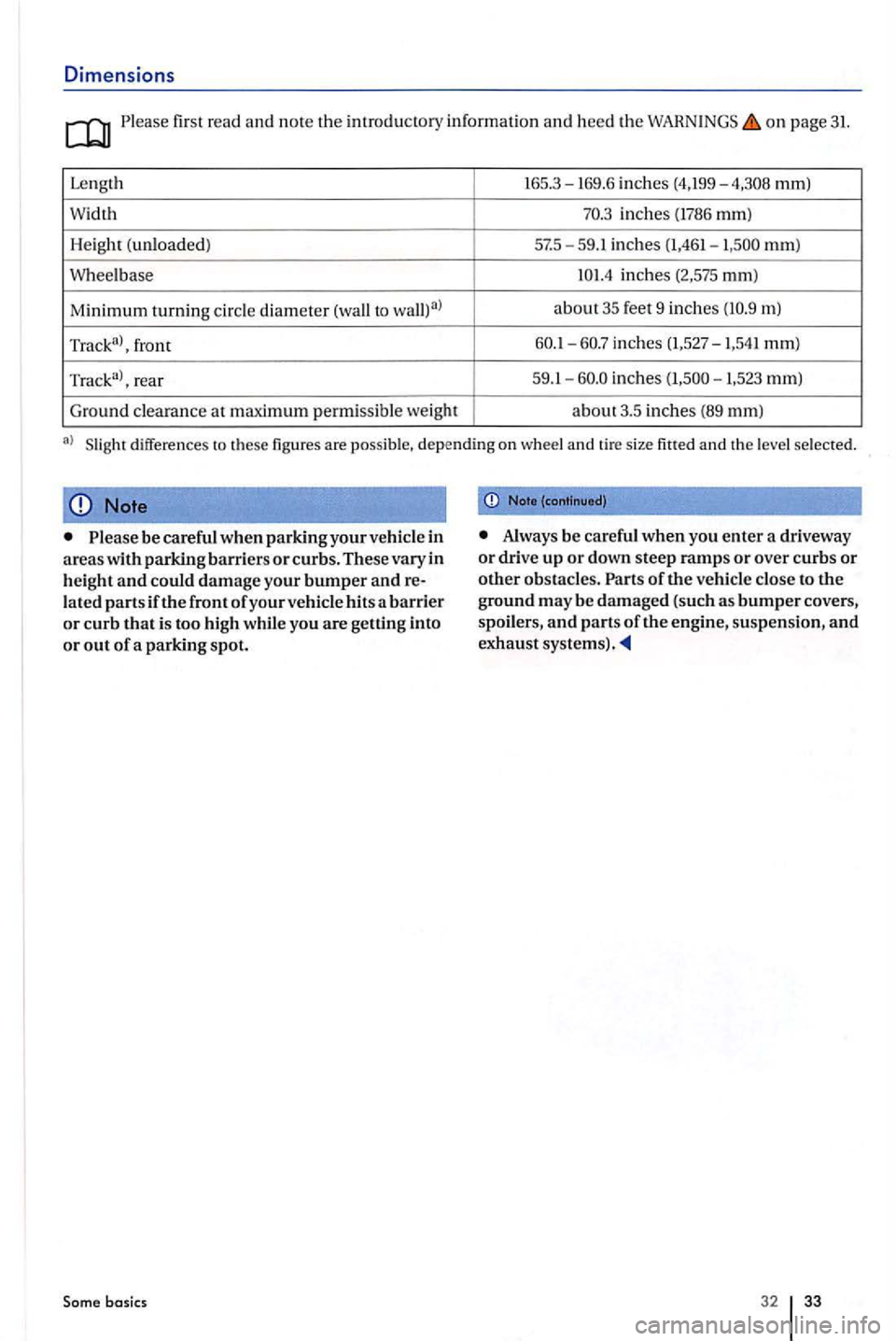
Dimensions
Please first read a nd note th e imrodu ctory informa tion and hee d th e on pa ge 31.
Le ngt h 165.3-
16 9 .6 in ches (4,199-mm)
W id th
inch es (1786 mm)
H eig
ht ( unload ed ) 57.5-59.1 in ch es (1,461-mm)
W h
eelb ase inch es (2,575 mm)
M inimum turning circl e diamet er
(wall to abou t 35 feet 9 inch es m)
inch es 1,523 mm)
G ro
und clearance at maximum p ermi ssibl e we ig ht about3.5 inch es (8 9 mm)
a)
Note
Plea se be careful when parking your vehicle in
areas with parking barriers or curbs. These vary in
height and could dama ge you r bumper and
basic s
Note (continued)
Always be carefu l when you enter a driveway or dri ve up or down steep ramps or over curbs or other obstacles . Part s of the vehicle close to the ground may be damaged (such as bumper covers ,
spoil ers , and parts of the engine, su sp en sion, and exhaust
32 33
Page 39 of 541
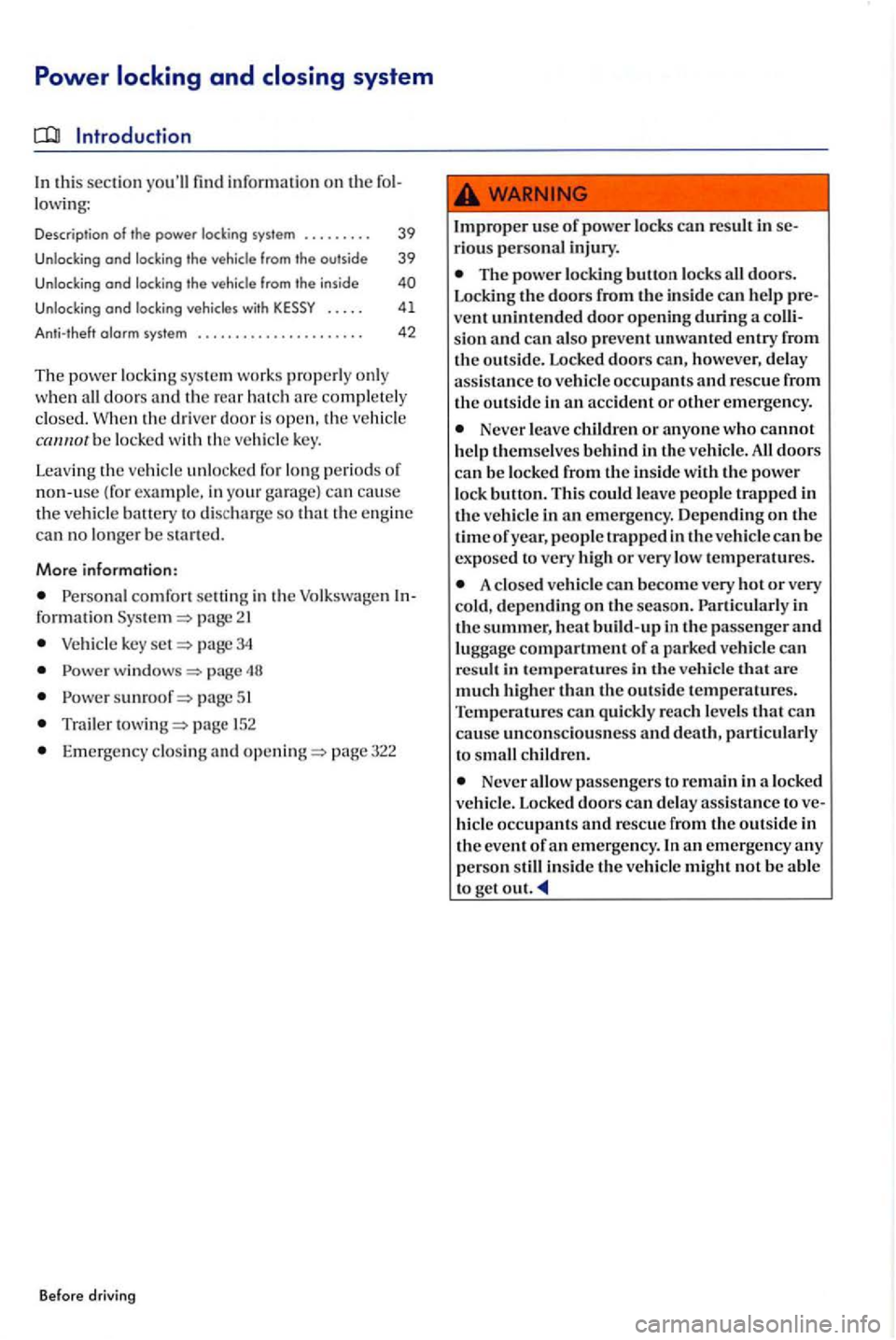
Power
Introducti on
In t his section you'll fin d information on th e fol
low ing:
Descr ip tio n of the power system . . . . . . . . . 39
Unlocking and locking the veh icle from outside 39
Unlocking and locking the vehicle from the inside
. . . . . 41
alarm system . . . . . . . . . . . . . . . . . . . . . . 42
The powe r locki ng sys te m works properly on ly
w he n all doors and t he rear ha tc h co mpl ete ly
cl osed. When th e driver door is open, th e vehicle b e locke d with the vehicle key.
Leavi ng the vehi cle unlocke d for long perio ds of
no n-use (for examp le, in your garage) can ca use th e veh icle battery to discharge so that the engine
ca n n o longer be sta rt ed.
More information:
Pe rsonal comfort settin g in t he Volkswagen Informatio n pag e 21
Vehicle key page 34
Powe r page
Power page 51
Trailer p age 152
Eme rge ncy clos ing a nd pag e 322
Before drivi ng
Improper use of powe r locks can res ult in se
r io us perso nal inju ry.
Th e powe r locki ng button locks all doo rs.
Lockin g th e doo rs f ro m the insid e ca n h elp pre
ven t unintended d oor o penin g during a colli
s io n and ca n also prevent un wa nted entry from th e outsid e. Lock ed d oors ca n, however, d e lay
a ss istance to vehicl e occupant s and resc ue from
th e outsid e in an accid ent or o ther em erge ncy .
Neve r le a ve childr en or an yone who cannot help themselves behind in the ve hicl e. All do ors
can be lo ck ed fro m th e in side w ith the power
l oc k button. T his co uld leave people trapped in ve hicl e in an em erge ncy. Dep endin g on the
tim e of peopl e trappe d in the ve hicl e ca n b e
ex po sed t o very high or very lo w t emperatures.
A close d ve hicl e ca n beco me very hot or very d ep ending on the seaso n. Particularly i n
th e summer, heat build -up in lh e passe nge r and lu ggage compartment of a parked ve hicl e ca n
res ult in temperatures in the ve hicle that are much hi gher tha n th e o utside temperatures .
T e mperatures can quickly reac h leve ls that can cause unconsci ousn ess and deatJ1, parti cularly
t o s mall childr en .
Neve r all ow passe nge rs to re main in a lo ck e d
ve hicl e. Locked doors ca n delay ass is ta nce to ve
hicle occupants and r esc ue f ro m the o ut side in
th e event of an emerge ncy. In an em erge ncy an y perso n still insid e th e vehicle might no t b e a ble
t o ge t
Page 42 of 541
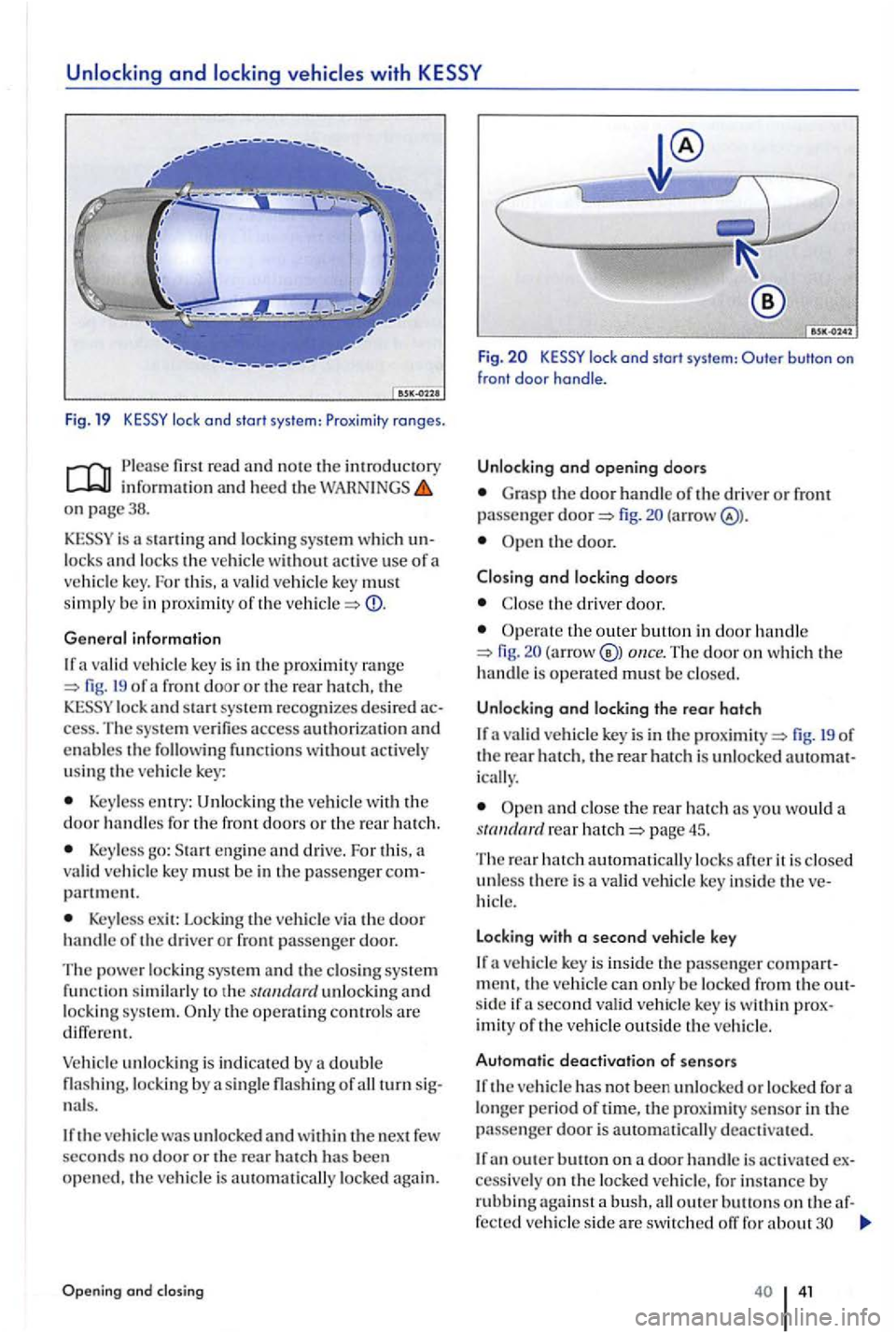
Unlocking and locking vehicles with
Fig. 19
on page38.
sta rting and system which unlocks and lock s the vehicle without active use of a vehicle key. For this, a valid ve hicle key must simply be in proximity of the
General information
If a va lid vehicl e key is in the proximity range fig . 19 of lock and start system recognizes desired access. T he system verifie s access authorization and enables the followin g functions without actively using the vehicle key:
Keyless entry: Unlocking the vehicle with the door handles fo r the front doors o r the rear hatch.
Keyless go: Start engine and drive. For this. a
valid vehicle key mus t be in the passenger com
partment.
Keyless exi t: Locking the vehicle via the door handle of the driver or fro nt passenger door.
T he power locking system an d the closing system fu nction similarly to th e unlockin g and locking system. the operating con trols are
Veh icle unlocking is indicated by double fla shing. locking by a single fla shing of all turn signals.
the vehicle was unlocked and within the next few seconds n o door o r the rear ha tch has been opened. the vehicle is automatically locked again.
and closing
Fig. lock and start system :
Grasp the door handle of the driver or front passenger fig . (arrow
the driver door.
the outer button in door h andle fig. (arrow The door on whic h the
h andle is operated mus t be closed.
Unlocking and locking the rear hatch
If a va lid vehicle key is in the fig. 19 of the rear hatch, th e rear hatch is unlocked automat
i c ally.
and close the rear hatch as you would a page 45.
The rear hatch automatically locks afte r it is closed unless there is a vali d ve hicl e ke y inside the ve
hicle.
Locking with a second vehicle key
I f a vehicle key is ins ide th e passenger compartment. the vehicl e can only be locked from the outside if a second vali d vehicle key is within proximity of the vehicle outside th e vehicle.
Automatic deactivation of sensors
If the vehicle has not been unlocked or locked fora longer period of time, tJ1e proximity sensor in the passenger door is automatically deactivated.
If an o uter button on a door handle is activated excessively o n the locked vehicle, for instance by rubbing against a bush, all outer buttons on the af-
fected ve hicle side are switched for about
Page 70 of 541
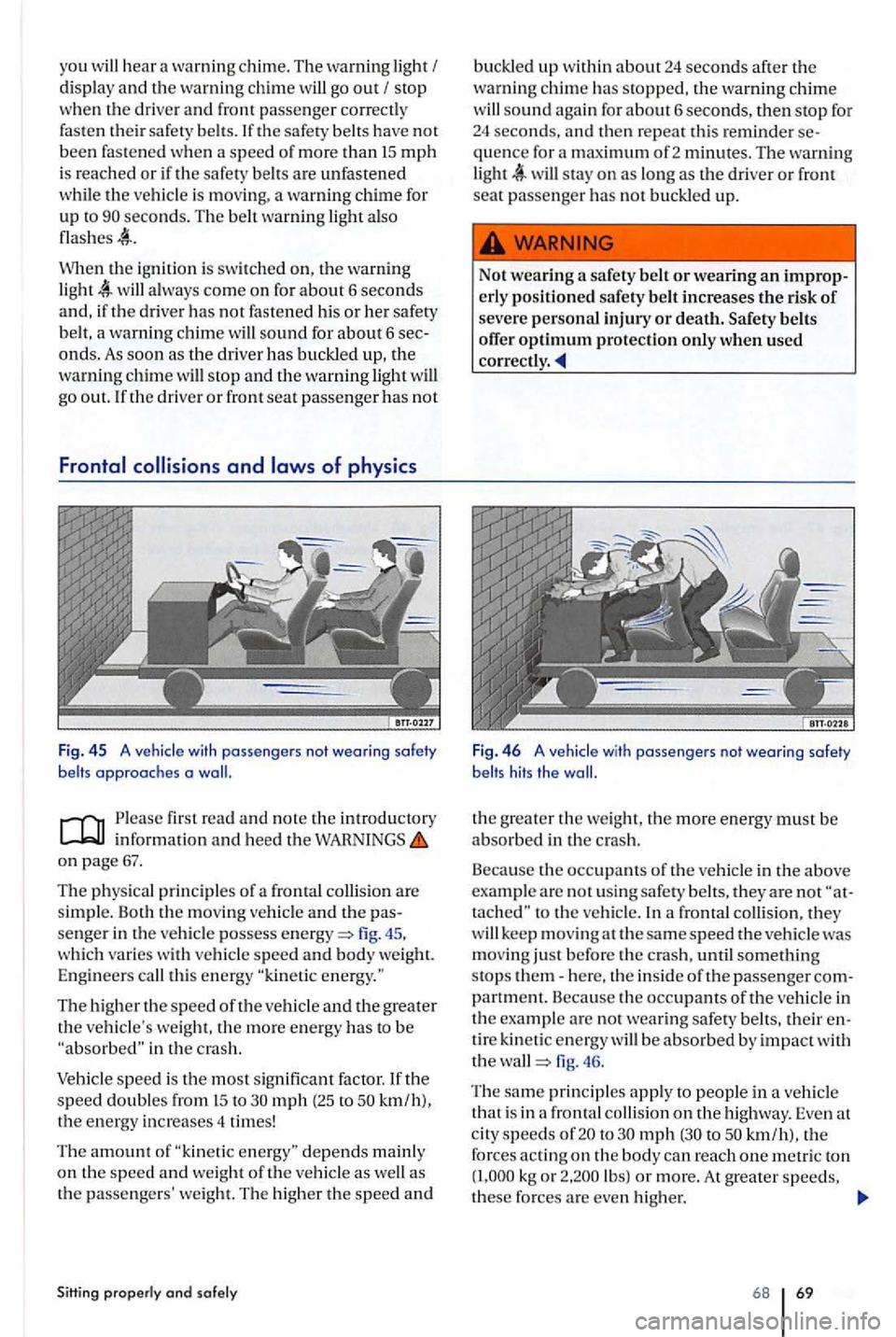
you hear a warn ing chime. The warning light stop
when the driver and front passenger correctly fas ten their sa fety belts. If the safety belts have not been fastened when a speed of more than 15 mph is reached or if the safety be lts are unfastened
while the vehicle is moving , a warning chime for
up to seco nds. The belt warning light also
When the ignition is sw itched on, the warning
and of phy sic s
Fig. 4 5 A vehicle with passengers not wearing safety belts approaches a
on page 67.
The physical principles of a frontal
fig . 45.
which varies wit h vehicle speed and body weight.
Engineer s
The higher the speed of the ve hicle and the greater
the vehicle's weight. the more en ergy has to be in the cras h.
Vehicle speed i s th e most sig nificant factor. If the speed doubl es from to mph (25 to kmlh),
the energy increases 4 times!
The amount of as
the passengers' weight. The higher the speed an d
Sitting properly and solely
buckled up within about24 seconds after the
warn ing chim e has stopped, the warnin g chime sound again for about 6 seco nds, then stop for 24 seconds, and then rep eat this reminder sequence for a
Fig. 4 6 A vehicle with passengers not wearing safety
belts hits the
the greater the we ig ht, the more energy must be abso rbed in the crash.
Beca use the occupants of th e vehicle in the above
example a re not usi ng safety belts, they are not
kee p m oving at the same speed the vehicle was
mo vin g just before the crash, until somethin g
stops th em-here, the inside of the passenger com
partment. Because the occupants of the vehicle in
th e exa mpl e are not wearing safety belt s, th eir en
tire kine
tic energy be absorbed by impact with
the fig. 46.
Th e
same pri ncipl es app ly to p eople in a veh icle
th at is in a fron ta l
to mph to kmlh), the forces acting on th e bod y can reach one metri c ton kg o r lbs) or more. At grea te r speeds,
th ese forces are even hi ghe r.
68 69